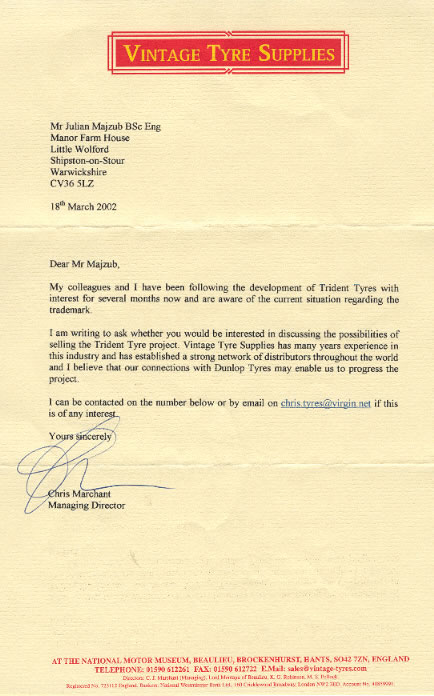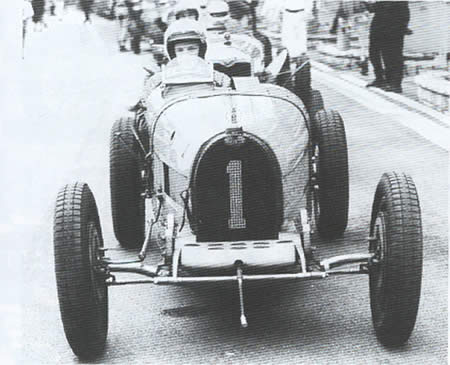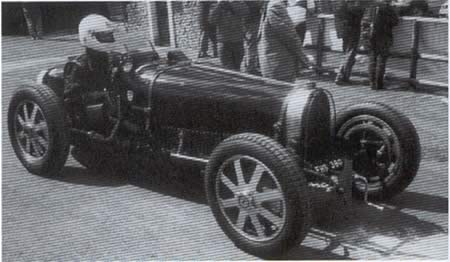Conflict with Dunlop
As some of you may know, I have changed the name of my tyres from Trident to Blockley due to an objection raised by the solicitors acting on behalf of Dunlop Tyres Ltd.
The new tyres were launched at the VSCC's 2002 April Silverstone Meeting, shortly after interest in the purchasing of the new project by Dunlop's "Sole Worldwide Distributor" - Vintage Tyre Supplies. Since then Blockley produces over 60 tyre sizes (beaded edge, straight sided, cross ply and radials, even millimetric sizes) as well as a vast range of inner tubes and rim bands. . .

If interested, some details of the conflict are covered in an article I wrote for "Bugantics" in the Summer 2002 issue, which I reproduce below -However in fairness, I should point out that Dunlop's Mr Haywood has stated that he disagrees with much of what I've written in this "self serving article".

I believe the one thing that really lets down the overall appearance of our cars is the tyres fitted to them. As a result I started looking into what I'd really like from a tyre and then approached the manager at Dunlop to see if they would be interested in producing something along my ideas. After a lack-luster reaction I later offered to pay for one of the moulds, which seemed to be the sticking point, but there was still no interest. When the manager was later replaced I made a point of seeing his successor (the present incumbent) but, again, to no avail.
A number of my cars, and those of my family, get used on the road shod with the 5.00 x 19 Dunlop race tyre and I was determined to get something more authentic in time for when my 26M Maserati was ready for the road. Years before, just to stand the car on, I thought of having some old carcasses remoulded and hand cut to a more traditional looking pattern but soon realised there was a lot more to it - unfortunately to do the job properly the whole thing needed changing. 'Seek and you shall find' and it's so true. Derek Freathy was at the Goodwood Circuit Revival meeting a couple of years ago with a DB4 Aston Martin and was the first 'tyre man' I met who actually knew exactly what I was on about; not only this but he had gone one better and was in the process of producing the 4.00 x 19 Classico tyre. He had joined Dunlop in 1968, was manager of car racing in 1973 and was the first man to be made manager of all three divisions (cars/bikes/rallying). In 1987 he started Concours Tyre & Rubber to design and manufacture high quality inner tubes and rim bands. It seems to be a little known company outside the industry even though they produce the racing tubes we all have.
Within a month I'd commissioned Derek's company to produce a 5.00 x 19 tyre and started off by listing what I did not like about the racing Dunlop 5.00 x 19 that I'd been using on the Bugatti. I quite like the 5 stud tread style dating from the late 1930s and, although the tread width seems in keeping, the carcass is far too "fat". The existing mould dates from around 1948 so presumably it was redesigned at this juncture. Being a race tyre it is my belief that it is not suitable for road use due to there being no sidewall protection and this could be a bit of a grey area which the insurance companies have never really cottoned on to: it always surprised me that David Black's insurance paid up after his monumental accident in France with his Type 51. More seriously it is my opinion that these Dunlop's have been designed for 4 inch rim widths whereas our Bugattis tend to be no more than 2.7 inches! Apart from rounding off the tread, which reduces the contact patch, this is what makes them even more bulbous than they already are. A friend of mine owns the Zagari photographic archive and by studying the photographs, coupled with checking period data, I think I can safely say that no competition car pre-war had a rim width exceeding 4 inches, which may come as a bit of a surprise to most of us. My just pre-war GP Alfa Romeo only had a 4-inch rim and that was for their widest 7.00 section tyre! I therefore surmised that if one were involved in a big and expensive enough accident an insurer could argue that the Dunlop tyres being used were too large for pre-war rim widths, information which is clearly stipulated in their data. Conversely if wider wheels were fitted to accommodate these inappropriate tyres (as so many have had to do) it could be pointed out that the vehicle has been modified out of specification -and rightly so because wider wheels tend to be built away from the brake drum which is why one often sees them laced on the inside and middle only, widening the track, altering steering geometry and so on and, worst of all in my view, making the cars look like out of character 'hot rods' which we have begun to take as the norm.
I decided on a pattern having three blocks not too unlike the tyres that have been produced for many years in South America. The people at Longstone Tyres provided paperwork pointing out the problem Dunlop had pre-war with their triple stud looking tyre and the uneven block wear associated with it. This is probably what led to it's being replaced with the tyre having 5 studs, of which there were two versions. Derek would have to make sure my tyres didn't suffer from any of this, as there is only so much period authenticity a customer will tolerate I would have thought! He eventually came up with a 'land to sea ratio' he was happy with and cleverly knitted the blocks together while experience led him to settle on a tread depth that did not give a spongy feeling under fast cornering. Since 1 wanted to use these on the 35B as well, they would have to be 'on the pace' for racing and I asked for a stiffer sidewall to stop them rolling under the rim during hard cornering. Derek wanted a stiffer sidewall in any case to make them road legal and eventually it all fell into place. To make sure of the best possible job I insisted they comply fully with current legislation for modern car tyres, which old car tyres appear to be exempt from at present: choosing the Department of Transportation (D.o.T) test for the U.S.A. as well as getting them speed rated for 130 mph for good luck. I wanted them not only to look fabulous but also be the highest specification 'pre-war' tyre ever produced and the standard by which all the others would use as a benchmark in future. This way one could drive to a meeting on a proper road-legal tyre, compete and then drive back, which is how it should be. Both the V.S.C.C. (of which I am proud to be an elected Director) and the F.I.A. have as a control compound, Dunlop's 204 compound, so I made sure the new tyres were no softer. Being Iranian, I chose for the sidewall a trademark showing one of my countrymen who had resided on the steps of the Apadana at Istakhar (Herodotus called it Persepolis) some 2500 years ago: it is finely machined on to the mould and is difficult to achieve crisply on the tyre. This was an extra way of ensuring it kept everyone on their toes during the manufacturing process! I chose the name Trident, registered the name at Companies House and got a website (there were over thirty combinations and all available) after having the Internet checked to make sure there weren't already tyres by that name. A Trident tyre was found in Australia as well as an outfit in the UK selling boat trailer tyres, both of whom I contacted.

When the test tyres finally arrived last summer I was bowled over, they were looking even better than the drawings had suggested. Fitted to my sisters ex Donald Healy/Tony Rolt blown 8C Triumph Dolomite, we had our first test in the pouring rain and they were sensational. Next we drove to VSCC Prescott in company with an 8C Alfa Romeo and realised we had something really special. After a lot more testing, while a few sets of the 4.50 x 19's were on loan to others for evaluation, I committed to production and started advertising, just as it appeared, coincidently, Michelin had withdrawn it's Englebert range.
At around this time I chanced on someone in a restoration shop with a previous Dunlop connection who told me I "would not be allowed to use the tyres" which I thought rather strange and on enquiring why this might be, was told I'd have to "wait and see". Sure enough some three months later, to coincide with my launch, I had the most outrageous three page letter form Dunlop's lawyers (as did the girl running the website) claiming that they had the rights to the name Trident and that I had used it to gain unfair advantage in the market place, using Dunlop's goodwill and reputation and that unless I "delivered up" all my tyres, my paperwork, including my internal delivery receipt record s (whatever they may be) and all sorts of other things, within seven days, they would institute legal proceedings without further notice. The letter finished "be in no doubt about the seriousness with which our client regards this matter" followed by "we suggest that you seek legal advice", which I did. Anyone reading my literature or website could be in no doubt my tyres had nothing to do with Dunlop. The lawyers also claimed that Derek Freathy had only been a salesman while at Fort Dunlop: I'm surprised they didn't go the whole way and insist he was the janitor there! It turned out the name Trident was registered, not to Dunlop but to Sumitomo in Japan, who had sold on Dunlop to Goodyear but kept the name, so we asked for proof of genuine use by Dunlop. This simple request took nearly a month for a response - still with no satisfactory proof - and I surmised that they were playing expensive games with me. So rather than assist in their slow motion plan, I set up a new tyre company, changed the name and changed the tyres. In march Dunlop's sole worldwide distributor of classic car tyres, Lord Montagu's Vintage Tyre supplies, expressed an interest in buying me out. Shortly afterwards Dunlop's spies told them what I was up to and that's when they got even more excited and said they would be serving something to me in person. The following week I launched my new Blockley tyres at the April V.S.C.C. meeting. Dunlop's motor sport manager had told the VSCC office that their "American lawyers" had said my tyres shouldn't be allowed there and that as a sponsor of the meeting he'd have no choice but to leave the circuit if he saw any. Having failed to get the VSCC involved, he changed his tune later, saying the office had misunderstood, and stayed throughout the weekend.
The tyres are now called Blockley as this is the village in Gloucestershire where our Northwick Park premises are situated. The situation at the time of writing is that the 4.50 and 5.00 tyres are here, as are the test tyres for 5.50/6.00 x 19 and 5.25/6.00 x 21. The big 19-inch is getting a gruelling test on Charles Dean's type 51 and we both ran our cars at Monaco. We were impressed, as earlier testing at Mallory Park had indicated we sould be. For example, in the wet practice I was some 11 seconds a lap faster that the next Dunlop shod car, which would have put me on the front row of the single seater ERA/Maserati race! It had been two years since I drove the Bugatti and I unfortunately got a little too eager and crashed while Charles and I were way out in front having our own race, but at least Charles went on to win in our maiden Blockley entry! He carried on testing at Pau the following weekend and still hasn't managed to chunk the rear tyres in the way he managed regularly with the make he usually runs. I'm now waiting to hear how much more testing is necessary before I can order the batch.